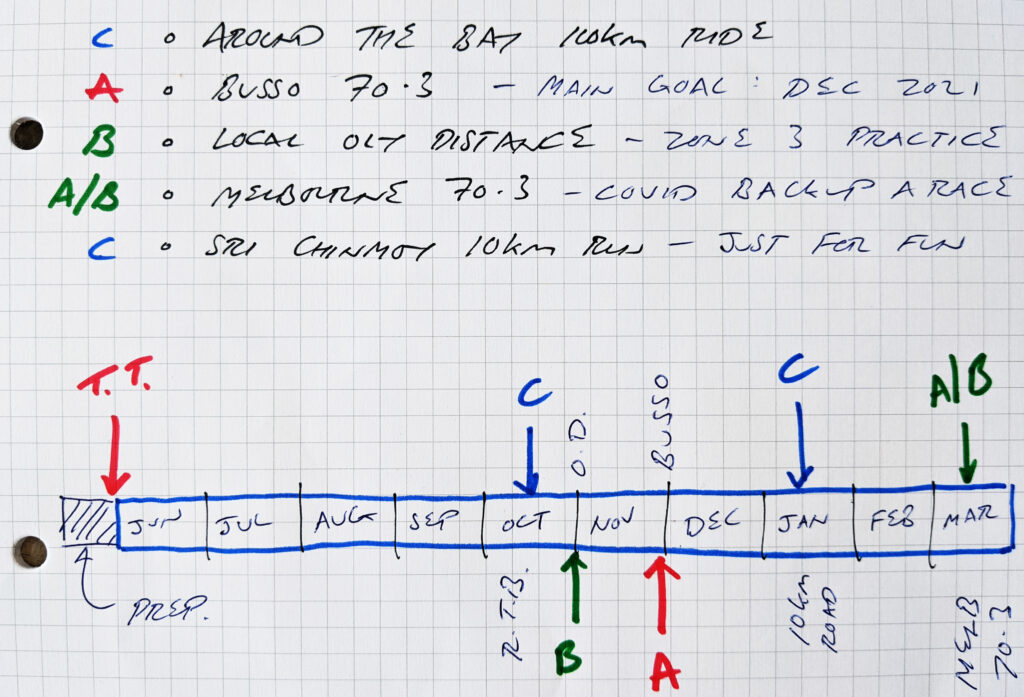Planning your race season: Periodization Part 1.

 Don’t dive blindly into a training programme until you know how the calendar progresses, and what each Phase is for.
Don’t dive blindly into a training programme until you know how the calendar progresses, and what each Phase is for.
As we tentatively get excited about Post-Lockdown events starting up again, now is the perfect time to plan our calendars. You may recall in The Triangle Of Change that we must adopt a Psychological approach to our development. That means we must question and confirm what we do, why we do it, and critically WHEN. In addition, we should be able to gauge how we are progressing and whether we are succeeding. Success isn’t only about what happened when you crossed the finish line; it’s about reflecting on every workout – easy or hard – and honestly rating your success.
The over-arching process is planning our entire calendar: Am I racing this season? When are the events? Can I clearly describe in just one or two sentences what my goals are this year?
These – seemingly obvious – questions and answers need to be recorded and referred to often by both athlete and [if you have one] your coach. Once the event dates are locked in, we can begin to write a Periodization Plan around them. Don’t get me wrong, if an athlete is content on getting fit as their priority with the occasional race day fun thrown in, it’s totally acceptable to swim, run and ride when they can and when they feel like it. But… if you want to get the absolute most out of your body and your available time, an accurate plan is priceless. The best plans not only provide structure around event dates but also the key detail about what sort of training we do at what time.
If there is no map to refer to, how do you know you’re on the right road????
If you are used to training in a squad environment, you will notice that most people are on the same timeline as you, aiming at similar event dates… whether it’s a local sprint or fun race series, or the same long distance event interstate. You may even be one of a handful of athletes aiming at Age Group World Championship qualification. You can already hear that there are majority athletes and minority athletes: at one end of the spectrum, a rough plan handed down by a squad coach is going to be just what you need. At the the other – minority – end of the spectrum, you are much more likely to need a ‘Bespoke’ programme planned just for you. That said, if you are in the minority and have a coach writing a programme for you, they should know exactly how YOUR calendar is built. If you ask them what Phase you are in – and why – they should have the answer. If they don’t, you may want to consider pushing that agenda or weighing up your other options.
The structure provided by the Events Calendar and Phases within the Training Programme can be wrapped up in one word: PERIODIZATION. These are our building blocks for success.
These building blocks can be Micro, Macro and Miso. I shall explain. (I also made up the Miso thing. You’ll see.)
As soon as possible, I will start mapping-out a Periodization Plan with an athlete and getting to grips with the outline of their very own calendar. The widest ‘umbrella view’ of the years’ training and racing (Macro) usually spans about 9-10 months and can contain numerous races, fun events, trips away, time off, B Races, C Races.. all sorts. I wouldn’t recommend an athlete aims at more than two A Races in a single year, however. Whether it’s the first time we’ve met – or I’m chatting with an athlete who has worked with me before – my note pad starts looking something like this:

The Periodization Plan is the answer to about 90% of an athlete’s future queries.
- “Should I do this today?”
- “I didn’t do that, I did this; is that correct?”
- “What am I doing in four weeks’ time?”
- “Why was that session different to this time last week?”
- “When do I get a cut back and confirm week?”
“What does the Periodization Plan say?”
Before any serious training can start, I have my athletes carry out Time Trials. In my post Let’s be specific. I explained the importance of testing as we negotiate a full pre-race programme for ONE event. And thus begins one of the first ‘Miso‘ planning tasks: this is neither an umbrella view nor a Micro inspection of how each day and week looks but a focus on a single event: This is your A Race. The Five-Step process listed in that article which applies to one event is as follows:
- Set the goal
- Carry out testing to ascertain CURRENT ability
- Set about completing a training programme based upon the above
- Repeat steps 2 and 3 until the key race is close
- Set a race plan based upon current ability
- Execute the plan
Testing- crucially – allows us to manage an athlete’s expectations from a very early stage. If an athlete (or incompetent coach) attempts to shortcut or ignore some of these steps, they may as well not plan at all. Just pluck a random time or pace from your head and cross your fingers. The chances of injury and failure have just increased ten fold. For example, if your Zone 3 pace for a half marathon is 5min/km in a test session a few weeks out from the race, the chances of you finishing in under 90 minutes are slim. And by the way, if any part of your brain is now is thinking “Just run faster surely?” then you are someone who really needs structure and intelligence in your training!
Whatever the A Race distance, the circa six-month Miso Process will usually adopt the same framework of Preparation, Base, Build, and Peak, before Race. This does however assume the athlete has been moving and exercising recently and isn’t currently injured. Age Group triathletes have a terrible habit (okay they have MANY!) of convincing themselves they can fix an injury, build base fitness and get strong all in the space of 12 weeks. This is not only kind of dumb, but goes entirely against the Periodization strategy as well as putting the Base Phases at risk… the most important to endurance athletes.
Too many of these athletes think they can do a little training here and there for three months, only really putting in some solid effort with 12 weeks to go… when the “Huffing and Puffing” workouts begin. Historically, I would say this was more common among male athletes than female, but recently I’ve decided it’s the Type A Character males AND Females that have somehow convinced themselves the higher intensity workouts are the only ones that benefit them. The simplest way to debunk this quiet frankly backward thinking is to focus on why the First Phase after preparation is called BASE.
Next time, we’ll look at how each of the Phases come together whether they are Micro, Miso or Macro.
W.
